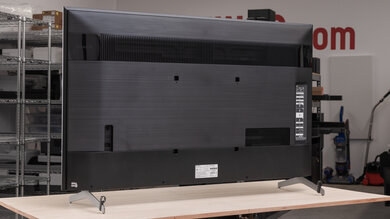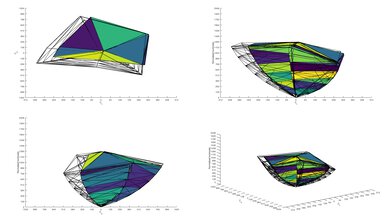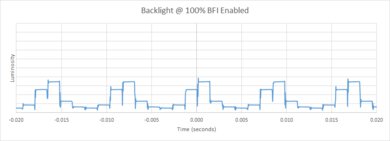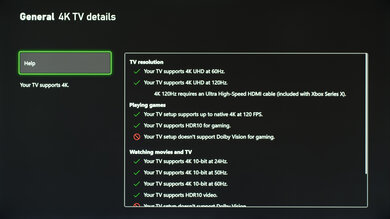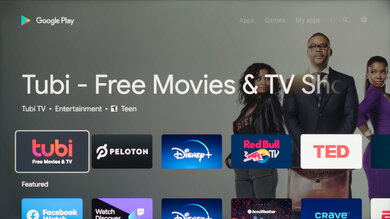The Sony X900H, also sold as the X90CH at Costco, is a great 4k TV for nearly any type of content. It has a VA panel with an excellent contrast ratio and a full-array local dimming feature that makes blacks look even better in the dark. It's well-suited for bright rooms, as it has decent reflection handling and gets bright enough to easily overcome glare. It displays fast-moving scenes with minimal blur thanks to its quick response time and optional Black Frame Insertion feature. Gamers should be happy with its low input lag, which remains low even when playing in 4k with 10-bit HDR. It has variable refresh rate (VRR) support once you update it to its latest firmware, but it doesn't support FreeSync and it doesn't work at the same time as the local dimming feature. Sadly, its viewing angles are narrow, so images look washed out when viewed from the side.
Our Verdict
The Sony X900H is a great TV for mixed usage. Its picture quality is great thanks to its excellent contrast ratio, high peak brightness, and wide color gamut. HDR content also looks good, with rich colors and highlights that pop for the most part. Gamers should appreciate its fast response time, low input lag, and VRR support after a firmware update. Unfortunately, it's less suited to watching with larger groups because it has narrow viewing angles that make the image look washed out from the side.
- Excellent contrast ratio.
- Fast response time.
- Great peak brightness.
- Receives VRR support after a firmware update.
- Narrow viewing angles.
- VRR disables the local dimming feature.
The Sony X900H is excellent for watching movies. It has a high native contrast ratio, combined with a full-array local dimming feature, that produces deep, uniform blacks. It can also upscale low-resolution movies without issue, and it removes judder from any source. That said, there's some stuttering in low frame rate content because of its fast response time.
- Excellent contrast ratio.
- Good local dimming.
- Excellent black uniformity.
- Some stutter in lower frame rate content.
The Sony X900H is good for watching TV shows. It has decent reflection handling, and it gets bright enough to overcome glare, so it's well-suited to watching TV in the daytime. It can also upscale lower-resolution content from cable boxes without issue. On the other hand, it's not recommended for wide seating arrangements because its narrow viewing angles make the image look washed out from the side.
- Great peak brightness.
- Decent reflection handling.
- Narrow viewing angles.
The Sony X900H is good for watching sports. It has an impressive response time, making motion look clear in fast-moving content. It also has decent reflection handling and is bright enough to fight glare in well-lit rooms. It's not ideal if you like watching the game with a large group, though, since the image quickly loses accuracy when viewed from the side.
- Fast response time.
- Great peak brightness.
- Decent reflection handling.
- Narrow viewing angles.
The Sony X900H is an excellent TV for gaming. Motion looks clear thanks to the fast response time, and it has a remarkably low input lag. If you prefer gaming in the dark, its high contrast ratio and good local dimming produce deep blacks. It also has two HDMI 2.1 ports for advanced consoles, and it has G-SYNC compatibility and HDMI Forum VRR support once you update it to its latest firmware. Sadly, you can't enable the VRR and local dimming at the same time, though.
- Excellent contrast ratio.
- Low input lag.
- Fast response time.
- Receives VRR support after a firmware update.
- VRR disables the local dimming feature.
- No FreeSync support.
- VRR and local dimming can't be enabled at the same time.
The Sony X900H is great for watching HDR movies. It has a wide color gamut for HDR and gets reasonably bright, although HDR content looks best in dark to moderately lit rooms. Its high contrast ratio produces deep inky blacks, and it has full-array local dimming to further improve black levels. Unfortunately, low frame rate content stutters a bit due to the TV's fast response time.
- Excellent contrast ratio.
- Good local dimming.
- Excellent black uniformity.
- Receives VRR support after a firmware update.
- Some stutter in lower frame rate content.
The Sony X900H is impressive for HDR gaming. Its gaming performance is impressive thanks to its fast response time and low input lag, which stays low even in HDR. It has a wide color gamut and gets bright enough to bring out some highlights. HDR content looks especially good in the dark because of its high contrast ratio. Unfortunately, it can't support a 4k @ 120Hz signal and Dolby Vision at the same time, although 4k @ 120Hz still works with HDR10. It also supports VRR, but not with Dolby Vision or the local dimming feature.
- Excellent contrast ratio.
- Low input lag.
- Fast response time.
- VRR disables the local dimming feature.
- Can't do 4k @ 120Hz and Dolby Vision at the same time.
- VRR and local dimming can't be enabled at the same time.
The Sony X900H is great for use as a PC monitor. It can display proper chroma 4:4:4, which is important for text clarity, and it has a remarkably low input lag, making for a responsive desktop experience. It also has a fast response time so there's minimal blur behind fast-moving objects like a mouse cursor. Unfortunately, though, it has narrow viewing angles, so the image looks washed out at the edges of the screen if you sit up close.
- Low input lag.
- Fast response time.
- Decent reflection handling.
- Narrow viewing angles.
Changelog
- Updated Jul 08, 2025: We uploaded the latest brightness measurements and uniformity photos for the Accelerated Longevity Test.
- Updated Apr 17, 2025: We uploaded the latest brightness measurements and uniformity photos for the Accelerated Longevity Test.
- Updated Feb 11, 2025: We uploaded the latest brightness measurements and uniformity photos for the Accelerated Longevity Test.
- Updated Nov 20, 2024: We uploaded the latest brightness measurements and uniformity photos for the Accelerated Longevity Test.
Check Price
Differences Between Sizes And Variants
We tested the 55 inch Sony X900H (XBR55X900H), and for the most part, we expect our review to be valid for the 65 inch (XBR65X900H), the 75 inch (XBR75X900H), and the 85 inch (XBR85X900H). It's sold as the Sony X90CH at Costco. In Europe, there's also the XH9296 and the XH9096. Both are basically the same TV as the X900H, but they come with a two-way position stand to accommodate smaller tables. Also, the 65 inch size and larger of the X900H have a different speaker configuration and are expected to have better performance.
| Size | North America Model | Costco Model | EU Model |
|---|---|---|---|
| 55" | XBR55X900H | XBR55X90CH | KD-55XH9005 |
| 65" | XBR65X900H | XBR65X90CH | KD-65XH9005 |
| 75" | XBR75X900H | XBR75X90CH | KD-75XH9005 |
| 85" | XBR85X900H | XBR85X90CH | KD-85XH9005 |
If someone comes across a different type of panel or if their Sony X900H doesn't correspond to our review, let us know and we will update the review. Note that some tests, such as the gray uniformity, may vary between individual units.
Our unit of the X900H was manufactured in May 2020; you can see the label here.
Popular TV Comparisons
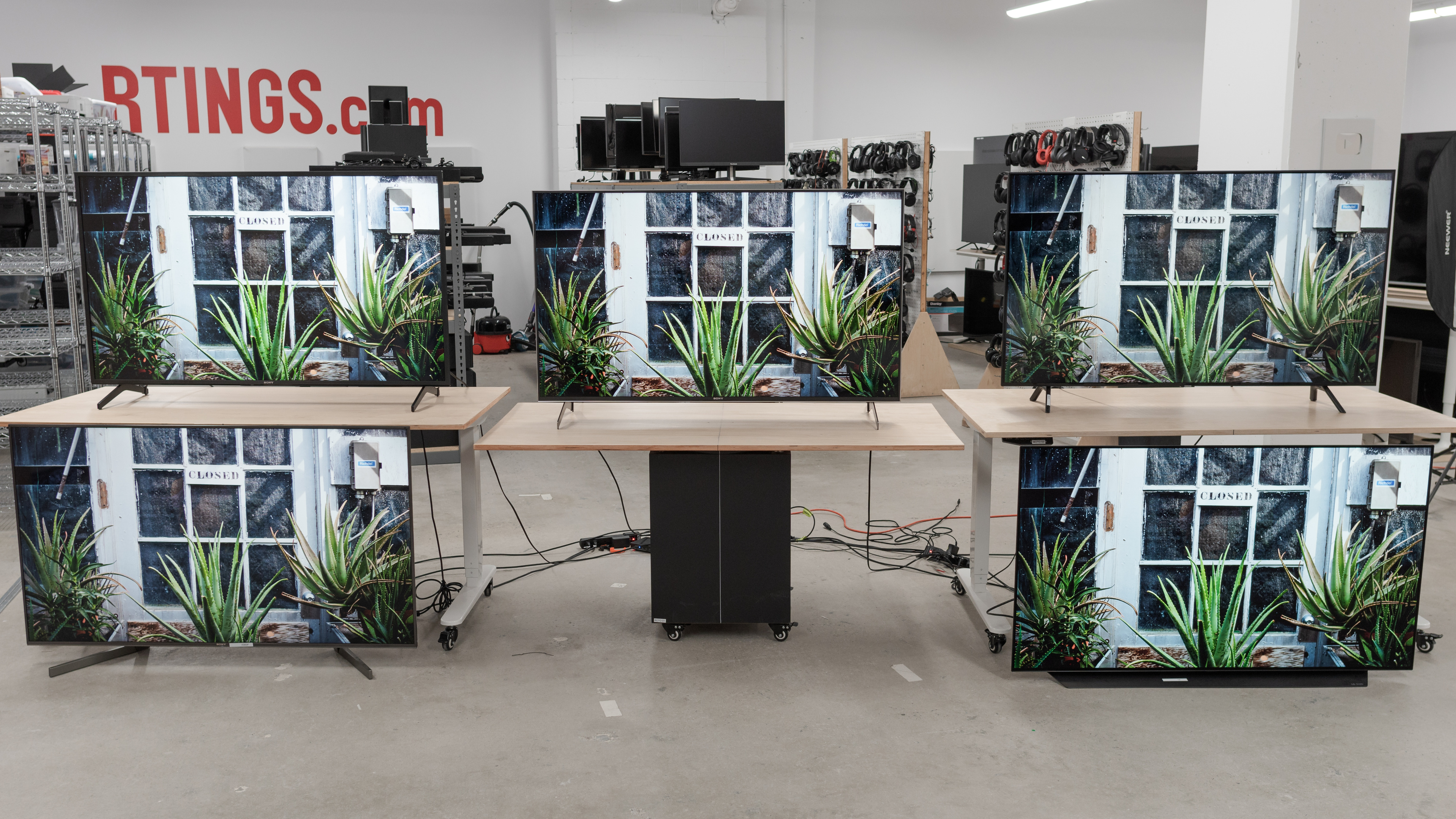
The Sony X900H is an overall great TV for most uses. It's very similar to its sibling, the Sony X950H, but is a better option for gaming due to its lower input lag. There are some tradeoffs, though, as the X900H doesn't get as bright and has narrower viewing angles compared to the X950H. For other options, check out our recommendations for the best TVs, the best 4k HDR TVs, and the best 4k gaming TVs.
The Sony X900H and the Samsung Q70A both perform well, although the Sony delivers better picture quality. While the Samsung has a higher native contrast ratio, the Sony's is still high, and it has a full-array local dimming feature to improve black levels. The Samsung has a lower input lag and comes with FreeSync support.
The Sony X900H and the Sony X85J are very similar overall. The X85J has a higher native contrast ratio, but the X900H has a full array local dimming feature that can reduce blooming in dark scenes and improve contrast. On the other hand, the X85J has a flicker-free backlight, and the more recent Google TV interface is a bit faster than the older Android TV 9.0 interface on the X900H.
The LG CX OLED is better than the Sony X900H. The LG is an OLED TV that can produce perfect blacks, which the Sony can't. The LG has wider viewing angles, better reflection handling, and its near-instantaneous response time results in almost no motion blur. They both support VRR, but the CX has FreeSync support.
For most uses, the Samsung Q80T is better than the Sony X900H. The Samsung has a faster response time, lower input lag, and FreeSync support, making it a better option for gaming. The Samsung also gets brighter in HDR content to make highlights pop, and its reflection handling is significantly better. However, the Sony has a higher contrast ratio and better local dimming, so it's a little better for dark room viewing.
Test Results

The Sony X900H has a sleek design, very similar to the Sony X950H. The metal feet are simple and hold the TV well, although you can't adjust their position to suit smaller tables. The back has some visible screws in the corners, but overall the TV looks nice and should look good in any living room.
The back of the TV looks very similar to the Sony X950H, with the same horizontal brushed texture. There are clips included in the box to tie the cables to the feet for cable management.
The Sony X900H is a bit thicker than most premium TVs we've tested in 2020, but it shouldn't stick out when wall-mounted. The inputs are side-facing, making them easier to access when wall-mounted compared to the Sony X900F.
This TV has great build quality. It feels well-built and doesn't wobble much, as the metal stand supports the TV well. However, the plastic near the inputs flexes a bit. There are some visible screws where the back panel attaches to the borders, and there's a bit more give in this area, but it isn't very noticeable and shouldn't be an issue for most people.
Update 08/16/2021: We retested the Sony X900H with the latest firmware, PKG6.0466.0059NAA. Contrast with local dimming has improved a bit, but it's not a noticeable difference.
The Sony X900H has an excellent native contrast ratio, although contrast may vary between units. It's higher than that of the Sony X950H, as it doesn't have Sony's 'X-Wide Angle' layer, which has the side effect of lowering the contrast ratio. The local dimming improves the contrast a bit, but not by much. That said, blacks still look deep, making it a great choice for dark room viewing. If you want a TV with an even better contrast ratio, check out the Hisense H9G.
Update 11/01/2021: We rechecked the peak brightness after updating to the final VRR firmware, v6.1534, but nothing changed.
Update 10/26/2021: We retested the peak brightness with the latest firmware, in the new 'Enhanced format (VRR)' mode. It's less bright overall than our posted brightness measurements because local dimming isn't available in this mode. We compare the brightness in the VRR mode with the brightness in 'Enhanced format' with local dimming disabled and found that there's no difference at all.
Update 08/16/2021: We retested the Sony X900H with the latest firmware, PKG6.0466.0059NAA. SDR peak brightness decreased a tiny bit overall, but it's not a noticeable difference. On the other hand, the TV isn't dimming small highlights as much anymore, so the 2% windows are closer to other scenes.
This TV has great SDR peak brightness. It's more than enough to fight glare, so you shouldn't have any issues using the TV in a well-lit room. However, the brightness varies depending on the content, and small areas are dimmer, as seen in the 2% and 10% windows.
We measured the SDR peak brightness after calibration, using the 'Custom' Picture Mode. Local Dimming and X-tended Dynamic Range were both set to 'High'.
If you want an even brighter image and don't mind losing accuracy, we reached 638 cd/m² in the 25% window using the 'Vivid' Picture Mode, with Local Dimming and X-tended Dynamic Range on 'High', and Contrast at max.
Update 08/16/2021: We retested the Sony X900H with the latest firmware, PKG6.0466.0059NAA. Someone had reported that the latest firmware broke auto local dimming and that it was now necessary to toggle the local dimming feature between 'High' and 'Medium' for it to work properly again. We tried to reproduce this issue, but our unit doesn't appear to be affected by this bug.
Update 06/22/2021: We've added two new videos demonstrating the local dimming feature with real content.
The full-array local dimming is good. It looks very similar to the Sony X950H, but with less blooming. There's a bit of dimming, though, and some small details are crushed in darker areas. It's good at making highlights in the background pop without being overly distracting; however, it doesn't handle highlights in the foreground as well as the X950H.
Local dimming in 'Game' mode looks and functions the same as it does outside of 'Game' mode. However, you can't enable the local dimming if you have VRR enabled.
Update 10/26/2021: We retested the peak brightness with the latest firmware, in the new 'Enhanced format (VRR)' mode. It's less bright overall than our posted brightness measurements because local dimming isn't available in this mode. We compare the brightness in the VRR mode with the brightness in 'Enhanced format' with local dimming disabled and found that there's no difference at all.
Update 08/16/2021: We retested the Sony X900H with the latest firmware, PKG6.0466.0059NAA. With the latest firmware, the TV is slightly dimmer in HDR, but it's not a noticeable difference.
Update 06/22/2021: We've retested the HDR peak brightness with Local Dimming set to 'Medium'. In that mode, the 2% and 10% windows aren't dimmed by the algorithms, resulting in a more consistent peak brightness across different content, but some scenes aren't as bright.
Update 03/12/2021: We've retested the HDR peak brightness with the latest firmware (version PKG6.0414.0055NAA). There's a slight drop in the real scene brightness, from 556 cd/m² to 526 cd/m². Overall, the 2% windows are a bit dimmer, while all the other windows are slightly brighter. The ABL result increased from 0.050 to 0.053. The score has been adjusted accordingly.
The HDR brightness is adequate. It gets bright enough to deliver a fairly good HDR experience, especially if you're watching in a dark to moderately lit room, but it doesn't look as punchy in a bright room setting. The overall brightness of scenes is good, as the EOTF follows the target almost perfectly but rolls off toward the TV's peak brightness, meaning that highlights can't appear quite as bright as intended. The brightness also varies a lot depending on the content with Local Dimming set to 'High'. If this variation bothers you, setting it to 'Medium' results in less variation in peak brightness, but also a slightly dimmer image in some cases. If you want a TV with exceptionally high brightness in HDR, check out the Samsung QN85A QLED.
We measured the HDR brightness before calibration, using the 'Custom' Picture Mode, 'Expert 2' Color Temperature, and with Local Dimming and X-tended Dynamic Range set to 'High'.
If you find HDR content too dim, you can make it brighter by using the 'Vivid' Picture Mode, with Local Dimming, X-tended Dynamic Range, and Advanced Contrast Enhancer all set to 'High'. These settings result in a much brighter image, as you can see in this EOTF.
Update 08/16/2021: We retested the Sony X900H with the latest firmware, PKG6.0466.0059NAA. With the latest firmware the TV is slightly dimmer in HDR, but it's not a noticeable difference.
Update 03/12/2021: We've retested the HDR brightness in Game Mode with the latest firmware (version PKG6.0414.0055NAA). The real scene brightness dropped from 688 cd/m² to 669 cd/m². All windows are slightly dimmer but shouldn't be noticeable. The most notable changes are in the 2% peak and sustained windows, both losing roughly 50 cd/m². The ABL result increased from 0.030 to 0.035. The score has been adjusted accordingly.
In 'Game' mode, HDR is somewhat brighter. This is especially noticeable in real scenes. As with 'Game' mode turned off, the brightness varies quite a bit depending on the content.
We measured 'Game' mode HDR brightness after calibration, using the 'Game' Picture Mode with Local Dimming and X-tended Dynamic Range set to 'High' and the Color Temperature set to 'Expert 1'. All extra settings were turned off.
The Sony X900H has excellent black uniformity, but this may vary between units. Without local dimming, the entire screen looks a bit grayish, and there's only some faint clouding around the top and bottom edges of the screen. With local dimming enabled, uniformity is much better throughout the screen, and surprisingly, there's very little blooming around the test cross.
Like most VA panels, this TV has narrow viewing angles, and unfortunately, it doesn't have Sony's 'X-Wide Angle' layer to improve it. The image loses accuracy fairly quickly when moving off-center, so it's not the best option for large rooms or wide seating arrangements.
This TV has decent reflection handling. It struggles mostly with direct reflections, so it's best to avoid placing the TV opposite bright lights. There's an updated version of the 85 inch model of this TV, the Sony X91J, that has a bit better reflection handling.
The color accuracy is excellent out-of-the-box, but this may vary between units. There are minor inaccuracies with blue and red, and the white balance is only slightly off. The color temperature is very close to our 6500K target. Gamma is also close to the 2.2 target, but most scenes are too dark and bright scenes are over-brightened.
After calibration, color accuracy is outstanding. White balance, gamma, and color temperature are nearly perfect. However, there are still some inaccuracies with reds and blues, but it shouldn't be noticeable in most content.
You can see our recommended settings here.
The Sony X900H has a BGR subpixel layout. It doesn't affect picture quality, but it can affect text clarity when using the TV as a PC monitor. You can read more about it here.
Update 02/15/2021: The DCI P3 and the Rec. 2020 color space graphs were inversed.
Update 08/16/2021: We retested the Sony X900H with the latest firmware, PKG6.0466.0059NAA. We remeasured the color gamut and found that it has increased slightly. It's not a noticeable difference, though.
This TV has a good color gamut, wide enough for HDR content. It has excellent coverage of the DCI P3 color space used in most HDR content, but coverage of the wider Rec.2020 is just okay. If you want a similar TV with a better color gamut, check out the Vizio P Series Quantum 2020.
We don't expect VA panels to experience permanent image retention, as the VA panel in our long-term test appears immune.
This TV has an optional Black Frame Insertion feature to help reduce motion blur. Unfortunately, the backlight's minimum flicker frequency is 120Hz even when playing 60Hz content, which results in some image duplication.
To enable BFI, set Motionflow to 'Custom' and adjust the Clearness slider to your preference.
To activate Sony's X-Motion Clarity Plus feature, which helps to make the image look clearer and brighter in fast-moving scenes, set Motionflow to 'Custom' and adjust the Clearness slider to '1', and the Smoothness slider to '2'.
The Sony X900H can interpolate lower frame rate content up to 120fps to make motion look smoother, also known as the 'Soap Opera Effect'. Motion looks good when enabled and we didn't notice any issues.
If you want to use motion interpolation on native 60fps content, set Motionflow to 'Custom', with the Smoothness slider set to 'Max' and the Clearness slider set to 'Min'. For native 30fps content, set Cinemotion to 'Auto'.
Due to the TV's fast response time, there's a bit of stutter when watching lower frame rate content. It's more noticeable with 24fps content since each frame is held on for longer.
This TV can remove judder from all sources. For 24p content, it does so automatically, so there's no need to change any settings. To remove judder from 60p, 60i, and content from native apps, set Cinemotion to 'Auto', Motionflow to 'Custom', and the Smoothness and Clearness sliders to their minimum.
Unfortunately, there's a minor issue while playing 23.976fps content from an external source, including most movies on DVD or Blu-ray. The TV skips a frame approximately every 42 seconds when all motion processing settings are disabled.
The Sony X900H has VRR support once you update it to the latest firmware. It's G-SYNC compatible as it works with an NVIDIA RTX 3060 graphics card without any screen tearing, including 4k @ 120Hz games. There aren't any of the flicker issues that the Sony X90J has either. 1080p and 1440p signals also work, but 1440p is upscaled to 4k. It works without any problems with the Xbox Series X, and because the Xbox supports both FreeSync and HDMI Forum VRR, it's confirmed that the TV supports HDMI Forum VRR as FreeSync doesn't work. Sadly, you can't enable the local dimming if you already have VRR enabled.
Update 03/04/2022: Sony released an update to include full VRR support with firmware PKG6.1576.0180NAA. However, we couldn't get proper VRR input lag readings because the TV kept crashing. We experienced the same issue with some other TVs like the Sony X90J, and we're looking into it. We also removed the VRR input lag results from past tests since those are now incorrect.
Update 10/19/2021: We retested the input lag without VRR after the latest update. We found that the input lag didn't change at all with the latest update, and our new measurements are within the margin of error of the test, so we didn't change anything in our review.
Update 10/08/2021: The Sony X900H received VRR support after an update to firmware PKG6.1288.0155NAA. We measured the VRR input lag with our Radeon RX580 PC, but since we don't normally measure the input lag with that PC, we didn't include those results. Also, those results are incorrect as of the latest firmware update.
This TV has a remarkably low input lag. It's low as long as you're in 'Game' mode, and it's the lowest with 4k @ 120Hz games. PC users can be in either 'Game' or 'Graphics' mode to get the lowest latency. Input lag remains low even when playing at 4k @ 60Hz + 10-bit HDR, but it increases significantly if motion interpolation is enabled, so it isn't recommended.
Update 10/08/2021: The latest firmware PKG6.1288.0155NAA that adds VRR support doesn't change the blurry image with a 4k @ 120Hz signal.
Update 08/16/2021: We retested the Sony X900H with the latest firmware, PKG6.0466.0059NAA. Unfortunately, the blur issue with a 4k @ 120Hz signal still hasn't been resolved. We also did a side-by-side comparison with the Sony X950H, as we had received reports that the X900H is blurrier than the X950H, even with regular content. The X950H looks a bit better due to its higher peak brightness and better colors, but image clarity and blurriness is the same.
Update 06/22/2021: We retested 4k @ 120Hz support, and unfortunately, the issue hasn't been fixed yet.
Update 02/15/2021: We previously indicated that 1440p @ 60Hz is supported natively, it is not. It only works through a forced resolution. We've also retested 1440p @ 120Hz, and it still doesn't work. 1080p @ 120Hz works and is supported natively.
Update 11/26/2020: We updated the TV to firmware version PKG6.0414.0055NAA and checked to see if it fixed the issues with chroma 4:4:4 at 4k @ 120Hz. Text looks a bit better, but it's still blurry, as seen in this photo.
Update 10/27/2020: We updated the TV to the latest firmware (version 6.0384) and retested it with an HDMI 2.1 source.
Update 09/30/2020: We've retested the X900H's ability to display proper chroma 4:4:4 with the latest firmware, as we've received reports that it functions in all picture modes. Unfortunately, the results haven't changed. Chroma 4:4:4 is only possible in 'Graphics' or 'Game' mode.
The Sony X900H supports most common resolutions, except for 1440p @ 120Hz. It properly displays 4k @ 120Hz and doesn't skip frames. Chroma 4:4:4 is supported at all resolutions, and only requires that you be in 'Game' or 'Graphics' mode. However, text looks a bit blurry with chroma 4:4:4 at 4k @ 120Hz, as you can see in this photo. For full-bandwidth signals like 4k @ 60 + 10-bit HDR, set HDMI Signal Format to 'Enhanced Format' for the input in use.
Update 03/04/2022: After a firmware update (version PKG6.1576.0180NAA) the Sony X900H now has Auto Low Latency Mode (ALLM) support. It automatically switches into Game Mode when you launch a game from a compatible device like the Xbox, and there are no extra settings required.
Update 01/28/2022: Some users have reported seeing stutter in some content after updating their TV to Android 10. We tried to reproduce the issue but didn't notice any stutter on our unit.
Update 11/09/2021: We changed the 'PS5, Variable Refresh Rate' result, as the TV now supports VRR, but the PS5 doesn't.
Update 11/01/2021: We retested the X900H with the latest firmware update, v6.1534. There are still issues with 4k @ 120Hz gaming, and it's still halving the resolution in games, displaying at 3840 x 1080.
Update 10/08/2021: The Sony X900H received VRR support after an update to firmware PKG6.1288.0155NAA. We noticed with Destiny 2 on the Xbox Series X that the resolution is reduced to 3840x1080 and the 'Open Director' box flashes between white and gray, which you can see here.
The Sony X900H has two HDMI 2.1 ports (ports 3 and 4), and it supports most, but not all, resolutions for new gaming consoles. When setting the HDMI Signal Format to 'Enhanced Format', it can support a 4k @ 120Hz signal but not Dolby Vision, as you can see here. However, when it's set to 'Enhanced Format (Dolby Vision)', it can't support a 4k @ 120Hz signal, as seen here. This, unfortunately, means that users have to choose between 4k @ 120Hz or Dolby Vision when using the Xbox Series X. For VRR, you have to set it to 'Enhanced Format (VRR)', and that disables the local dimming and Dolby Vision.
Update 10/28/2020: We incorrectly listed all four ports to have HDMI 2.1, but only HDMI 3 and 4 have HDMI 2.1 support.
Update 10/27/2020: We updated the TV to the latest firmware version and retested it with a HDMI 2.1 source.
There's a composite input for older devices such as DVD players, but it requires an adapter, which isn't included in the box.
Update 10/27/2020: We updated the TV to the latest firmware (version 6.0384). eArc now works on the HDMI 3 port.
The Sony X900H has eARC support when you update it to its latest firmware version. This allows you to send high-quality audio such as Dolby Atmos via TrueHD to a compatible receiver using an HDMI connection.
This TV has a decent frequency response. The sound profile is reasonably well-balanced and dialogue sounds clear. The bass is punchy, but it doesn't produce a deep rumbling sound. It gets very loud without causing too many compression artifacts, which is great for large or noisy environments. The 65 inch, 75 inch, and 85 inch sizes of this TV have a different speaker configuration and are expected to have better performance.
The distortion performance is disappointing. It doesn't distort too much at moderate volume levels, but there's a lot of distortion when playing near max volume.
Update 07/15/2020: It's been mentioned to us that apps and settings can be customized to show on the quick menu and quick settings list, which further reduces the amount of time required to access them. The 'Time Taken' values have been updated.
The Sony X900H runs on Android TV. It runs very smoothly, and we didn't notice any issues while testing. The interface is clean and fairly easy to navigate.
During our testing, we didn't notice any ads, but there's some suggested content on the home page and within the app store.
The Google Play Store offers a ton of apps available to download, and they work well. The built-in Google Chromecast allows you to cast anything you want from your phone.
The Sony X900H comes with the same large and stylish remote as the Sony X850G. It has shortcut buttons to Netflix and the Google Play Store. There's also a Google Assistant button that allows you to ask for most common demands, such as changing inputs or searching for content in apps, but we weren't able to change the TV's settings.
Like the Sony X950H, the TV's control is now just a single button, located beneath the Sony branding at the center of the bottom bezel. This button lets you turn the TV On/Off, change the input source, change the channel, adjust the volume, and restart the TV.




